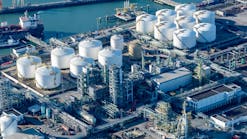IOC investigating explosion at Barauni refinery
Indian Oil Corp. Ltd. (IOC) is investigating an explosion that occurred in mid-September during turnaround maintenance at its 9-million tonne/year (tpy) Barauni refinery in Begusarai District, Bihar.
The incident took place at about 10:30 a.m. local time on Sept. 16 during light up of a burner in one of the furnaces of the refinery’s atmospheric-vacuum distillation unit 1 (AVU-1), causing minor injuries to 5 refinery employees and 14 contract workers in the area, IOC said in a release.
Of the 19 workers injured, 11 have already been discharged after receiving first aid from the refinery’s on-site hospital as well as a nearby local hospital. The conditions of the other eight injured remain stable, according to the company.
The cause of the incident—which occurred during the refinery’s planned maintenance shutdown that began on Aug. 20—is now under investigation.
While IOC confirmed the explosion did not impact other units at the site, the operator disclosed no details regarding the extent of damage to AVU-1.
The incident comes amid IOC’s ongoing 148.10-billion rupee project to expand crude processing capacity at Barauni by 3 million tpy to 9 million tpy, including addition of downstream polymer units at the site as part of IOC’s strategy to help meet growing domestic demand for petroleum products in India (OGJ Online, Aug. 6, 2021; Aug. 3, 2020).
According to the latest project documents available from IOC, India’s Ministry of Environment, Forest, and Climate Change (EFCC), and Envirotech East Pvt. Ltd.—which completed the project’s environmental impact assessment study in November 2018—the Barauni capacity expansion will include construction of the new 9-million tpy (AVU) to replace the refinery’s three existing AVUs, which will be idled (OGJ Online, Apr. 8, 2020).
Alongside addition of a new 1.2-million tpy diesel hydrotreating unit, the project also entails installation of major grassroots units, including:
- Two new sulfur recovery units, each with a capacity of 80 tonnes/day.
- A new 304,000-tpy isomerization unit.
- A new 360,000-tpy naphtha hydrotreating (NDHT) unit designed to treat naphtha feed moving specifically to the isomerization unit.
- A new 1.2-million tpy diesel hydrotreating unit.
- A new 61,000-tpy hydrogen generation unit.
- A new 1-million tpy once-through hydrocracking unit.
- A new 562,000-tpy propylene recovery unit.
- A new 200,000-tpy polypropylene unit.
- A new 390,000-tpy LPG treatment unit.
- A new 880,000-tpy naphtha splitting unit.
- A new 500-tonnes/hr amine recovery unit.
- A new 220-tonnes/hr sour water stripping unit.
- A new 6,178-kg/hr flue gas amine treating unit.
The expansion project also will involve revamps and upgrades to increase capacity of current units at the refinery, including:
- Expanding the refinery’s existing 210,000-tpy NHDT unit and catalytic reforming combined capacity to 300,000 tpy.
- Expanding capacity of the existing 1.4-million tpy residue fluid catalytic cracking unit to 1.7 million tpy.
- Expanding capacity of the existing 500,000-tpy Coker B to 662,000 tpy (OGJ Online, Apr. 7, 2021).
The Barauni crude processing capacity expansion currently remains on schedule for commissioning by April 2023, IOC most recently told investors (OGJ Online, June 14, 2021).

Robert Brelsford | Downstream Editor
Robert Brelsford joined Oil & Gas Journal in October 2013 as downstream technology editor after 8 years as a crude oil price and news reporter on spot crude transactions at the US Gulf Coast, West Coast, Canadian, and Latin American markets. He holds a BA (2000) in English from Rice University and an MS (2003) in education and social policy from Northwestern University.


